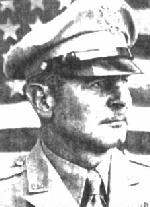|
In addition, the submarines U.S.S. Thresher and U.S.S. Trout were operating off the Japanese coast, watching for enemy fleet movements and weather conditions.
The fleet crossed the 180th Meridian on Friday, April 17, in a latitude considerably higher than Tokyo and following the same route that the Japanese took to bomb Pearl Harbor. At 2 P.M. that day we heard "Tokyo Rose" speaking from the Japanese Radio Station JOAK, telling her listeners why it was impossible that Tokyo would ever feel the sting of bombs.
Dawn of the 18th showed a stormy sea, so violent that the destroyers found themselves unable to keep up with the carriers and cruisers, so they and the tankers laid behind to be picked up on the return run. A 45 mile gale was blowing, breaking water over the HORNET's towering flight deck.
It was an ever present fear throughout the dash west, that we would be sighted by an enemy ship or patrol plane that would radio in an alarm, warning the Japanese of our coming.
At 2:10 A.M. that morning, we picked up two blips on the Radar Screen showing enemy ships dead ahead. We altered course to avoid them, and at dawn we launched reconnaissance planes from the ENTERPRISE. At 5:00 A.M. the ENTERPRISE pilots reported a picket boat 42 miles ahead, and an hour later a third vessel was sighted visually from the HORNET. Within ten minutes our cruisers and dive bombers were blasting them from the water, but there could be no assurance that they had not successfully sounded a warning.
We were still 550 nautical miles from our intended launching spot, 150 miles from our intended launching spot, 150 miles further away than desired. It was originally planned to fly the planes off in the afternoon of the 19th, which would permit the pilots to drop their bombs at night. Afterwards they would seek out forewarned, but unfamiliar, landing sites in Free China in the daylight of the next morning. As many months of planning had been put into this mission, it could not be abandoned this close to being successful.
Lt. Col. Jimmy Doolittle conferred with Admiral "Bull" Halsey and they decided to launch the aircraft as soon as they could be made ready. Gasoline tanks were topped off and extra fuel in five gallon cans were stowed aboard each airplane, as every ounce of fuel was needed to help the fliers reach their final destination.
At 7:00 A.M. came the call, "Army Pilots man your planes," and the twin-engine, fully loaded bombers, cranked up their engines with an ear-splitting roar. The spread of the bombers wings left only four feet of clearance between the right wing tip of the bombers and the carrier's island structure; the slightest veering from a white line painted down the flight deck would end in disaster.
The wind and seas were so strong that morning that sea water broke over the HORNET's flight deck. Lt. Col. Doolittle, in the first plane to be launched, charged off the deck at 8:24 A.M. on its way to Tokyo. The Flight Deck Launching Officer had to time each takeoff to coincide with the rise and fall of the bow to give the planes as much of a boost as possible when they left the fight deck. All planes were airborne by 9:20 A.M. But not without cost, one sailor in the flight deck handling crew lost his arm after being struck by a propeller.
Tokyo had been alerted for a large air raid with Japanese planes conducting a mock air raid. The real raid by the American planes followed so closely that the Japanese public never knew of our attack until it was over. No air raid sirens sounded for at least 15 to 20 minutes after Doolittle's Raiders were over the cities. The actual damage inflicted by our bombers on the enemy cities was not great by later bombing standards, but the Japanese officials had a difficult time explaining how such an attack could have happened and they suffered considerable "Loss of Face." The news of the attack on Tokyo gave a great boost to American and allied morale.
None of our attacking bombers were lost over Japan; one landed in RU.S.S.ia, fifteen others in China. Seventy-one of the 80 pilots and crewmen, including Lt. Col. Doolittle, survived the raid. One crewman was killed when he bailed out, two were killed in crash landings, five were interned in RU.S.S.ia, eight were captured by the Japanese and the rest managed to reach Free China and safety. Of the eight that were captured, three were executed, one died and four were freed at the end of the war.
Our part in this spectacular raid completed, the carriers HORNET and ENTERPRISE with their task force ships reversed course and made tracks for safer waters. Admiral Halsey made good our retreat without molestation, even though the Japanese launched both planes and ships in pursuit. Within three hours, the combat air patrols from both carriers attacked 16 enemy surface ships, sinking several of them, with one surrendering to the Light Cruiser U.S.S. NASHVILLE and its crew taken prisoner.
This bombing of Tokyo and other industrial cities in the Japanese homeland was a great "Morale Boosting" action for the American public, as a retaliation for the sneak attack at Pearl Harbor.
|

